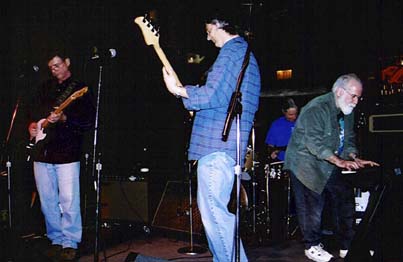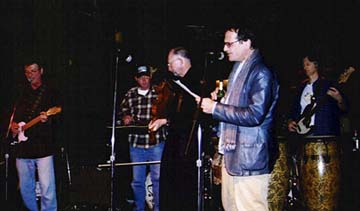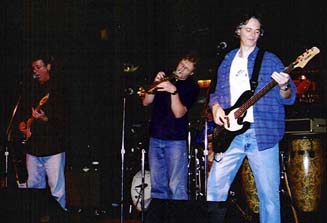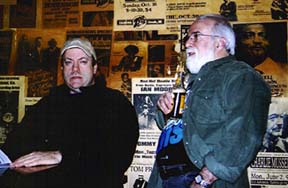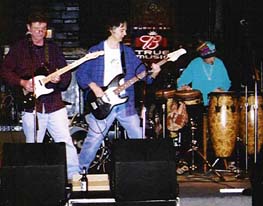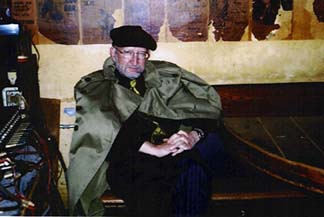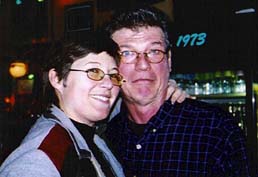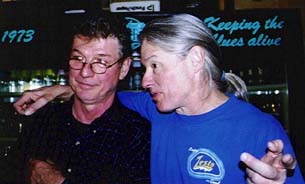Concert Preview
Trumpeter Roditi returns
March 16
for
another BMF concert in Lincoln
By
Tom Ineck
Early in its history, the Berman Music Foundation took an
interest in trumpeter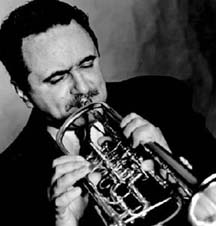 Claudio Roditi, bringing him to Lincoln for a performance with
saxophonist Greg Abate in February 1996. The concert at the
now-defunct 7th Street Loft also featured pianist Phil DeGreg,
bassist Bob Bowman and drummer Todd Strait, all of whom have
maintained close ties with the BMF.
Claudio Roditi, bringing him to Lincoln for a performance with
saxophonist Greg Abate in February 1996. The concert at the
now-defunct 7th Street Loft also featured pianist Phil DeGreg,
bassist Bob Bowman and drummer Todd Strait, all of whom have
maintained close ties with the BMF.
Roditi returns to Lincoln March 16 as guest soloist with the
Nebraska Jazz Orchestra at the Cornhusker Hotel ballroom, a
performance again sponsored by the BMF. Roditi may not receive the
worldwide recognition he so richly deserves, but he has friends and
supporters in the Heartland.
Referred to as the Kenny Dorham of the 1990s, Roditi has an
exciting edge in his neo hardbop approach. Born in Rio De Janeiro,
Brazil, in 1946, he began playing piano as a child, but turned to
the trumpet at the age of 12. Listening to records by Harry James,
Louis Armstrong, Red Nichols and others, he began mixing jazz with
his native music, during the 1960s bossa nova boom.
He moved to the United States in 1970 to study at the Berklee
College of Music in Boston, where he picked up an occasional gig
until moving to New York in 1976.
Among other leaders who called on him were saxophonists Charlie
Rouse and Joe Henderson, flutist Herbie Mann, percussionist Tito
Puente and pianist McCoy Tyner, but it was his relationship with
Cuban saxophonist Paquito D’Rivera beginning in the early 1980s that
best showcased his fiery Latin-tinged style. A versatile player on
both trumpet and flugelhorn, he has recorded in numerous jazz
settings and was a valuable member of Dizzy Gillespie’s United
Nation Orchestra.
As a leader, Roditi has recorded for various labels, including
Green Street (1984’s “Red on Red”), Uptown (“Claudio”), Milestone
(“Gemini Man” and “Slow Fire”), Candid (“Two of Swords” and the live
“Milestones”), Reservoir (“Free Wheelin’: The Music of Lee Morgan,”
“Samba Manhattan Style” and “Double Standards”), Mons (with the
Metropole Orchestra) and RTE (“Jazz Turns Samba” and “Claudio, Rio
and Friends”).
His solo work “Symphonic Bossa Nova” with Ettore Stratta and the
Royal Philharmonic, earned Roditi a Grammy nomination in 1995.
Roditi plans to continue to blend the two musical forms he loves.
As he told Stan Woolley in Jazz Journal International, “I am a
Gemini. I was born in one country and live in another but I love
them both, and both kinds of music, too.”
The following excerpts are from an interview by Gregory F. Pappas
April 7, 2001, in San Antonio, Texas:
Pappas: If you had to choose a few bars or a cut
representative of your music which would it be?
Roditi: A tune that I wrote called “Gemini Man” represents
best the way I feel about samba mixed with jazz. It is from an album
I also did by that name.
Pappas: What musicians would you like to play with (alive or dead)
and have not had a chance?
Roditi: I guess I have been very fortunate to play with
most of them: Raul De Souza (living now in France), Slide Hampton,
Edsel Machado (I was in his band before coming to the U.S.), Dom Um
Romao, McCoy Tyner (who even recorded some of my tunes) and Horace
Silver. I really wanted to play with Art Blakey and I talked with
him once. He asked me for my phone number but nothing came about.
Pappas: Are there any particular young musicians that you
think deserve wider recognition?
Roditi: There is a Brazilian piano player called Helio
Alves. He plays fantastic. Another one of the few that knows both
the Brazilian and Afro-Cuban tradition.
Pappas: You do travel a lot.
Roditi: Yes! You cannot survive if you stay put. I go to
Europe quite a bit. I have different groups that I play with,
sometimes in Holland but mostly in Germany. I wish I did not have to
travel so far and had more opportunities in the USA.
Pappas: Historically the most famous combination of
Brazilian with jazz is bossa nova. But are there other combinations
worth mentioning? I notice that there is something “harder” about
the approach to Brazilian jazz of musicians like Dom Um Romao, Airto
Moreira, Hermeto Pascoal and you.
Roditi: Let me explain to you what happen in Brazil in the
late ‘50s and early ‘60s. When I moved to Rio in 1964 (from a town
in the interior) it was the height of the bossa nova period. A
record label from Brazil called Musidisc issued in Brazil the entire
Pacific Jazz catalog, with artists like Chet Baker, Bud Shank and
Gerry Mulligan. Their LPs were available and cost much less than the
imported records. That is why cool jazz had such a direct influence
in that period, at least on bossa nova. Bossa was music that
belonged primarily to singers, guitar players, piano players and
composers. But at that time something else happened that I saw first
hand but you never hear about in the US. The guys that were playing
saxophone, trumpet, drums and trombone were mostly playing what we
called samba jazz. In other words, what you are calling a harder
approach was played there in the ‘60s. There were musicians that
grew up near the Favelas, like Edison Machado, that also loved Elvin
Jones and Art Blakey. They had to play hard!
top
|
Concert
Review
Scheps-Brock
Quintet sets house on fire
|
By Tom Ineck
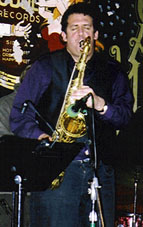 It is unfortunate that the Rob Scheps/Zach Brock Quintet is not a
household
name because they play like a house on fire! It is unfortunate that the Rob Scheps/Zach Brock Quintet is not a
household
name because they play like a house on fire!The quintet made its
Lincoln debut Jan. 22 at P.O. Pears, which has been the scene of
many a fiery jazz performance in the last couple of years, thanks to
the underwriting support of the Berman Music Foundation and
the weekly jazz programming managed by Arts Incorporated.
There is nothing conventional about Scheps’ approach to jazz, and
that makes his music very exciting. The oldest member of the quintet
by nearly a decade, he shepherds his younger sidemen through the
complex changes while allowing them ample freedom to improvise. What
results is a captivating performance capable of riveting the
attention of even the most jaded jazz fan and holding spellbound the
dozens of the University of Nebraska-Lincoln jazz history students
who frequent P.O. Pears, notebooks in hand.
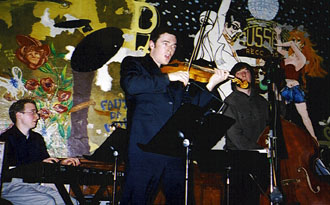 An
Oregon native, Scheps has lived and worked in Boston and New York
City, as well as performing worldwide with artists as diverse as the
Gil Evans Orchestra, trumpeters Clark Terry, Arturo Sandoval, Eddie
Henderson and Terumasa Hino, trombonist Roswell Rudd, singers Mel
Torme, Dianne Reeves and Nancy King, bandleaders Buddy Rich and Mel
Lewis, organist Jack McDuff and avant jazz legends Sam Rivers, Muhal
Richard Abrams, Henry Threadgill and Julius Hemphill. An
Oregon native, Scheps has lived and worked in Boston and New York
City, as well as performing worldwide with artists as diverse as the
Gil Evans Orchestra, trumpeters Clark Terry, Arturo Sandoval, Eddie
Henderson and Terumasa Hino, trombonist Roswell Rudd, singers Mel
Torme, Dianne Reeves and Nancy King, bandleaders Buddy Rich and Mel
Lewis, organist Jack McDuff and avant jazz legends Sam Rivers, Muhal
Richard Abrams, Henry Threadgill and Julius Hemphill.
Co-leader Brock, 29, draws on a broad tradition of jazz violin,
from Johnny Frigo to Stephane Grappelli and even fusion pioneers
Jean-Luc Ponty and Jerry Goodman. Born in Lexington, Ky., he pursued
his musical training in Chicago. For the band’s Lincoln appearance,
he brought along a couple of talented young Windy City musicians,
pianist Jordan Baskin, 24, and bassist Matt Ulery, 22. Rounding out
the quintet was drummer Morgan Childs, also 22, whom Scheps
recruited in Vancouver, B.C.
 Brock’s
piece “Mr. Shah” kicked off the proceedings with an irresistibly
clever funk riff, over which Scheps superimposed an extended tenor
sax solo, with the rhythm section comping like veterans. The
composer also took a solo on his five-stringed instrument, a
physical display of pyrotechnics that was, at the same time,
disciplined in its clean lines and melodic ideas. Brock’s
piece “Mr. Shah” kicked off the proceedings with an irresistibly
clever funk riff, over which Scheps superimposed an extended tenor
sax solo, with the rhythm section comping like veterans. The
composer also took a solo on his five-stringed instrument, a
physical display of pyrotechnics that was, at the same time,
disciplined in its clean lines and melodic ideas.
"First Morning at the Tower” was composed by bassist Ulery,
inspired by a visit to Italy. It was constructed on a complex melody
line that worked well as a basis for solos statements by Scheps on
tenor, Baskin on keys and Brock on violin. “Olivia’s Arrival” had
the familiar sound of a standard, but was in fact a little-known
tune by baritone saxophonist Gary Smulyan. Scheps and Brock
displayed a fine sensitivity in their harmonized lines, the two
instruments blending surprisingly well.
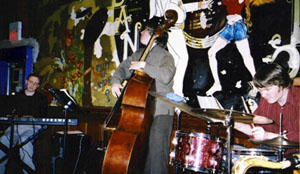 For his composition “New Homes,” Scheps switched to flute, an
instrument
closer to the violin’s range. Beginning at mid-tempo, the tune
accelerated as Scheps and Brock joined in a unison line, leading to
a flute solo with Baskin first comping on keys then segueing into a
full-blown solo. Brock also took another masterful, confident solo. For his composition “New Homes,” Scheps switched to flute, an
instrument
closer to the violin’s range. Beginning at mid-tempo, the tune
accelerated as Scheps and Brock joined in a unison line, leading to
a flute solo with Baskin first comping on keys then segueing into a
full-blown solo. Brock also took another masterful, confident solo.
Scheps again introduced an obscure tune with much merit. It was
Joel Weiskopf’s blazing “Tuesday Night Prayer Meeting,” a subtle
reference to the Charles Mingus swinger “Wednesday Night Prayer
Meeting.” It was a tightrope-walking showcase for Scheps on tenor
and Brock on violin, first locked in unison and then in successive
solos. Baskin joined the fray as all three took solos behind Childs’
skillful drum breaks.
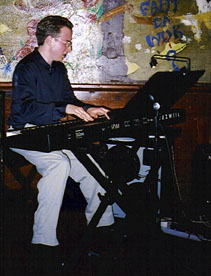 During
the break between sets, Scheps told me they like to keep the
audience guessing, sometimes alternating between the music of Cole
Porter and Nirvana. Neither of those extremes was heard that
evening, but the quintet did launch into the second set with Ornette
Coleman’s “Happy House,” a tune not heard every day. It allowed
Scheps to play “outside” on tenor sax and for Brock to show his
pizzicato skill, plucking the violin like a rock guitar. During
the break between sets, Scheps told me they like to keep the
audience guessing, sometimes alternating between the music of Cole
Porter and Nirvana. Neither of those extremes was heard that
evening, but the quintet did launch into the second set with Ornette
Coleman’s “Happy House,” a tune not heard every day. It allowed
Scheps to play “outside” on tenor sax and for Brock to show his
pizzicato skill, plucking the violin like a rock guitar.
Baskin contributed the lovely “Searching for Solace,” which had a
waltz-like lilt. Scheps, on flute, again joined harmonies with
Brock. Scheps introduced the ballad “Crestfallen,” saying that he
wrote it in Nebraska City, where the band had played the previous
night. Brock took the lead, and turned in a gorgeous reading of the
tune. “Little Jewel,” also by Scheps, featured a soulful piano
introduction and another great tenor solo by the composer.
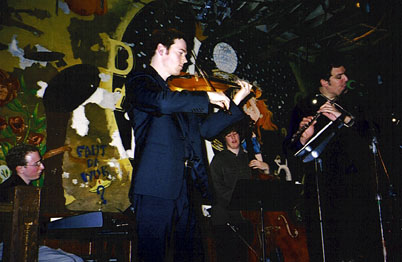 “Common
Ground,” a track from Brock’s CD “The Coffee Achievers,” was another
twin-voiced piece featuring Scheps on tenor and Brock on violin.
Finally, Scheps pulled out all the stops for “The Cougar,” first
working out on the tenor sax, then combining the flute mouthpiece
and the sax body to take a soaring solo on the “saxaflute.” “Common
Ground,” a track from Brock’s CD “The Coffee Achievers,” was another
twin-voiced piece featuring Scheps on tenor and Brock on violin.
Finally, Scheps pulled out all the stops for “The Cougar,” first
working out on the tenor sax, then combining the flute mouthpiece
and the sax body to take a soaring solo on the “saxaflute.”
It was the kind of over-the-top antic that few musicians could
pull off convincingly. Judging from the response, the Scheps-Brock
quintet convinced everyone in the audience.
top
|
Artist Interview
T.S. Monk
champions jazz as popular music
|
By Tom Ineck
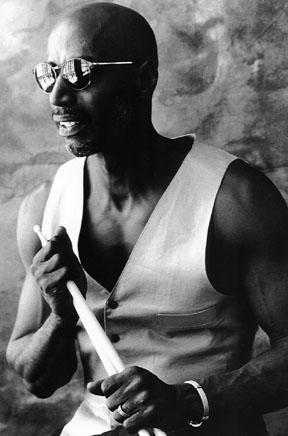 There is no more articulate and passionate advocate of jazz as
popular music
than T.S. Monk, the distinguished drummer and son of Thelonious
Monk. As chairman of the Thelonious Monk Institute of Jazz, he also
is the keeper of the flame, a responsibility that he takes very
seriously. There is no more articulate and passionate advocate of jazz as
popular music
than T.S. Monk, the distinguished drummer and son of Thelonious
Monk. As chairman of the Thelonious Monk Institute of Jazz, he also
is the keeper of the flame, a responsibility that he takes very
seriously.
When Monk and his band were scheduled to appear in Lincoln a
couple of months ago, I arranged a live radio interview to take
place during “NightTown,” my weekly jazz program on KZUM Community
Radio. Despite slow ticket sales that forced the concert’s
cancellation, Monk wanted to go ahead with the phone interview.
Familiar with his eloquence from an interview we had done for
publication in the Lincoln Journal Star more than a decade ago, I
jumped at the chance to chat with him again.
Several recent developments in Monk’s career, including the new
CD “Higher Ground” and the launch of Thelonious Records (and the
website www.monkzone.com) for his own recordings and those of his
father, provided plenty of subject matter for our 45-minute, on-air
conversation. Monk, as always, proved an easy interview.
On his fresh approach to Ray Bryant’s “Cubano Chant” (from
“Higher Ground”) and other standards that he has recorded: “The
great thing about the standard compositions is that they really
provide a framework that’s intergenerational, that’s chronologically
neutral in many, many ways, so it allows you to revisit a
composition and really bend it and twist it. Because it’s a
standard, it generally means that it has some fundamental, bedrock
elements that you really can’t do without. As long as they’re
incorporated, you still have the same tune.”
On the timeless accessibility of good music: “That doesn’t
change from genre to genre or era to era. Those elements that make a
hit tune, so to speak, are the same for everyone. It boils down to a
haunting melody that you will always remember, a great groove, and
generally, some harmonics that make you think and give you some
texture.”
On the importance of knowing jazz history and developing a
jazz vocabulary: “Jazz is a continuum, but in order for it to
continue, one must constantly revisit what’s gone before you, so
that you know that you’re in some sort of new territory, or at least
in a new region. Often, at least to my ear, a lot of the younger
jazz musicians don’t learn tunes the way we used to have to learn
tunes. You had to know 300 tunes, and what that does for the jazz
musician is to increase your vocabulary. You have to revisit the
music that’s preceded you in order to maximize your vocabulary, so
you can then go into the future and have something new to say.”
On the importance of working in the consistent context of a
band: “That’s key, in terms of finding your creative center. A
jazz musician’s only true home is in a band, and if you look at the
great musicians throughout the history of jazz, every single one
came from a great band. You can trace them back, whether it’s Bird
and Miles back to the Jimmie Lunceford band or you’re tracing
Coltrane back to the Miles Davis or the Monk band or you’re tracing
Monk back to the Coleman Hawkins band. We develop a vocabulary, and
that vocabulary is developed in order for us to converse. If one is
to truly converse properly, you have to talk to each other on a
continuous basis. You can’t have brief, intermittent conversations.
As you have those conversations, you develop ideas. It’s the same as
it is for the man on the street. It’s the same as it is in all the
other quarters of society. So, if you listen to what is played by
Miles with Red Garland, Jimmy Cobb and Paul Chambers, those records
were the result of many, many conversations over many, many nights.
The only way you can do that is by keeping a band together. The
great entrepreneurs in the recording industry years ago, people like
Alfred Lion, understood this clearly. That’s why you saw those bands
stick together. You saw Monk and (Charlie) Rouse together for years
and years. You saw Miles and Coltrane. You saw Wayne Shorter and Joe
Zawinul in Weather Report. You saw Miles and Herbie Hancock and Tony
Williams and Wayne Shorter and Ron Carter. Those are all creative
cauldrons. It does make a strong case for the continuum of a
creative process when musicians can play together regularly. When
you look at the (current) landscape of jazz, there aren’t many bands
that stick together. That’s had a negative effect on the overall
creative movement in the music.”
On the emergence of Wynton Marsalis in the early 1980s and the
“jazz star:” “The jazz recording industry got a little enamored
with the concept of what they might have misconstrued as ‘instant
stardom.’ As a consequence of that, we saw the jazz labels go on a
quest for about 15 years to see who could find the youngest, most
unknown ‘next,’ and it didn’t quite work out that way because that’s
a blueprint that we’ve taken from pop music and overlaid it on jazz.
It doesn’t work for jazz because it restricts the concept of artist
development, and artist development is the most critical factor in
the development of a jazz recording artist. In today’s recording
environment, my father, Charles Mingus, Eric Dolphy and maybe even
John Coltrane in his latter years would not have gotten a recording
deal. They were too different. They were doing exactly what they
were supposed to do, and right now the industry has gotten an
attitude of sameness. The bedrock of the music is individuality.”
On Thelonious Records and its mission: “It’s originally my
father’s dream, in that he recorded himself at home and other people
recorded him in all kinds of clandestine ways. Jazz musicians
pioneered the concept of the home production, the self-contained
production vehicle—I wrote the music, I played the music, I recorded
the music. Thelonious Records is about two things. It’s about the
Monk family, the branding of the Monk family, that is myself and my
father and our music. It’s also about new ideas. I can tell you
realistically that I’m two years away from the first new ideas, in
terms of signing an artist because getting up and running is the
critical thing.”
On the importance of marketing and promoting jazz: “I’m
very old-school, and very P.T. Barnum-oriented and I say, ‘Listen,
I’ve got this six-piece band and it’s baaaaaaaad. It will blow you
out. We will kick your you-know-what.’ That’s how I feel about my
band, and that’s how I feel about jazz in general. Jazz is the one
area in music that has enormous room for growth, and we have to take
advantage of that. We have to learn how to sell our products. We
have a product that has a shelf life that, we now know, can be as
long as 50 or 60 years. We know that we have a marketplace that is
international in scope. The concept of how you actually sell this
music is a little bit of a mystery, even though it seems to sell
year in and year out, at a slow pace. I don’t believe that slow pace
is a function of the art form. I think that slow pace is a function
of the industry, and so I’m looking to change it. If a few other
people get involved, we get that shift in the industry the way
country music had its shift in the ‘80s, the way r&b had its shift
in the ‘90s. I have been offended over the years. First, I was
offended by people who said that you couldn’t teach jazz in an
institution. We’ve been very successful, and in our 18th year, with
the Monk Institute. I got doubly offended by the people who said you
can’t really market jazz because it’s really not for the mainstream.
I think that’s absolutely ridiculous.”
On his concept of “cross-talking” and blending jazz styles:
“The umbrella of jazz is really quite vast, as far as I’m concerned.
Even though every jazz musician that I know is extraordinarily
versatile, I don’t see a lot of versatility being reflected in the
bands. Bands tend to stay in one little niche. Perhaps because I’m a
drummer, and I don’t have a melodic instrument to rest on, I like to
give you a lot of different looks. Although we change genres or
change idiomatically, we don’t change the instruments. That’s what
allows us to cross-talk, so we can please all of the people all of
the time.”
On his father, who died in 1984, and his mother, Nellie, who
died in 2002: “Without Nellie, we would have had no Thelonious
Monk. Nellie and Monk met when he was 17 and she was 12 years old,
and they started dating when she was 17 and he was 22. She
understood his artistry from day one, and she became all things that
one human being can be to another—a lover, a friend, a confidant, a
brother, a sister. Although I miss her incredibly, because not only
was she my mom but I was born on her birthday, I know that she and
Thelonious are together now. That’s the Romeo and Juliet of jazz.
That’s one of the great hookups that you ever had.”
On “Monk in Paris: Live at the Olympia,” a CD and bonus DVD
recently released on Thelonious Records: “Thelonious was really
a live artist. When you speak to people who had the opportunity to
see Thelonious perform live most of them say, ‘I went back and saw
him every night for two weeks,’ because he was the real thing.
Thelonious could play you 20 different solos on the same tune over
20 nights. On these recordings that I have now that we’re going to
be releasing over the next several years, the band is thumpin’. The
band is really swingin’. A lot of listeners are most familiar with
the CBS recordings that he did because those are the clearest, those
are the best recordings, and those probably have the highest
visibility, even more so than the Blue Note and Prestige recordings.
But even on those recordings, you don’t get the energy level that
Thelonious projected. In many ways, you could misconstrue Thelonious
as sort of a laid-back guy. But the reality is that this is the guy
who influenced John Coltrane and Miles Davis and Dizzy Gillespie and
a whole generation of the greatest who ever lived. And, it was
because he was very exciting. In these recordings that we have with
Thelonious Records, that’s what’s going to come out—how much fun
Thelonious was live. And, when you see Thelonious (on the DVD), then
a lot of the things he played make even more sense.”
On Thelonious Monk’s piano-playing style and philosophy of
“practice”: “Thelonious was a great player. The great piano
player Barry Harris once said to me that there were two players he
knew that he never heard ‘practice.’ They only played. They
‘practiced’ playing. That was Thelonious and his main protégé, Bud
Powell. When I think back, I say, ‘You know what, I never heard my
father play a scale. I never heard him do any of those exercises
that you always hear piano players doing, two-hand scales and all
that kind of stuff. What he would do was sit down at the piano at 10
o’clock in the morning and not stop until 8 o’clock, before he went
to the club at night to play his gig. He would be absolutely
performing.”
top
|
Performance Photo Feature
Jim Jacobi celebrates release of "Get Out!"
|
Veteran “punk rocker” Jim Jacobi had his CD release party Dec. 16 at
the Zoo Bar in Lincoln to celebrate his brand new endeavor, “Get
Out.” All the players on the disc were there to cameo their recorded
performances. Jacobi’s rhythm section, drummer Dave Robel and
bassist Craig Kingery, was joined by Butch Berman, piano; Dr. Dave
Fowler, fiddle; Steve “Fuzzy” Blazek, lap steel; and Charlie Burton
and Carole Zacek, vocals. Also in attendance were Rick Petty,
congas; Phil Shoemaker, guitar; and Brad Krieger, trumpet.
top
Editor’s Note:
At your request, we will mail a printed version
of the newsletter. The online newsletter also is available at this website
in pdf format for printing. Just click here: Newsletter
|

 Claudio Roditi, bringing him to Lincoln for a performance with
saxophonist Greg Abate in February 1996. The concert at the
now-defunct 7th Street Loft also featured pianist Phil DeGreg,
bassist Bob Bowman and drummer Todd Strait, all of whom have
maintained close ties with the BMF.
Claudio Roditi, bringing him to Lincoln for a performance with
saxophonist Greg Abate in February 1996. The concert at the
now-defunct 7th Street Loft also featured pianist Phil DeGreg,
bassist Bob Bowman and drummer Todd Strait, all of whom have
maintained close ties with the BMF. It is unfortunate that the Rob Scheps/Zach Brock Quintet is not a
household
name because they play like a house on fire!
It is unfortunate that the Rob Scheps/Zach Brock Quintet is not a
household
name because they play like a house on fire! An
Oregon native, Scheps has lived and worked in Boston and New York
City, as well as performing worldwide with artists as diverse as the
Gil Evans Orchestra, trumpeters Clark Terry, Arturo Sandoval, Eddie
Henderson and Terumasa Hino, trombonist Roswell Rudd, singers Mel
Torme, Dianne Reeves and Nancy King, bandleaders Buddy Rich and Mel
Lewis, organist Jack McDuff and avant jazz legends Sam Rivers, Muhal
Richard Abrams, Henry Threadgill and Julius Hemphill.
An
Oregon native, Scheps has lived and worked in Boston and New York
City, as well as performing worldwide with artists as diverse as the
Gil Evans Orchestra, trumpeters Clark Terry, Arturo Sandoval, Eddie
Henderson and Terumasa Hino, trombonist Roswell Rudd, singers Mel
Torme, Dianne Reeves and Nancy King, bandleaders Buddy Rich and Mel
Lewis, organist Jack McDuff and avant jazz legends Sam Rivers, Muhal
Richard Abrams, Henry Threadgill and Julius Hemphill. Brock’s
piece “Mr. Shah” kicked off the proceedings with an irresistibly
clever funk riff, over which Scheps superimposed an extended tenor
sax solo, with the rhythm section comping like veterans. The
composer also took a solo on his five-stringed instrument, a
physical display of pyrotechnics that was, at the same time,
disciplined in its clean lines and melodic ideas.
Brock’s
piece “Mr. Shah” kicked off the proceedings with an irresistibly
clever funk riff, over which Scheps superimposed an extended tenor
sax solo, with the rhythm section comping like veterans. The
composer also took a solo on his five-stringed instrument, a
physical display of pyrotechnics that was, at the same time,
disciplined in its clean lines and melodic ideas. For his composition “New Homes,” Scheps switched to flute, an
instrument
closer to the violin’s range. Beginning at mid-tempo, the tune
accelerated as Scheps and Brock joined in a unison line, leading to
a flute solo with Baskin first comping on keys then segueing into a
full-blown solo. Brock also took another masterful, confident solo.
For his composition “New Homes,” Scheps switched to flute, an
instrument
closer to the violin’s range. Beginning at mid-tempo, the tune
accelerated as Scheps and Brock joined in a unison line, leading to
a flute solo with Baskin first comping on keys then segueing into a
full-blown solo. Brock also took another masterful, confident solo. During
the break between sets, Scheps told me they like to keep the
audience guessing, sometimes alternating between the music of Cole
Porter and Nirvana. Neither of those extremes was heard that
evening, but the quintet did launch into the second set with Ornette
Coleman’s “Happy House,” a tune not heard every day. It allowed
Scheps to play “outside” on tenor sax and for Brock to show his
pizzicato skill, plucking the violin like a rock guitar.
During
the break between sets, Scheps told me they like to keep the
audience guessing, sometimes alternating between the music of Cole
Porter and Nirvana. Neither of those extremes was heard that
evening, but the quintet did launch into the second set with Ornette
Coleman’s “Happy House,” a tune not heard every day. It allowed
Scheps to play “outside” on tenor sax and for Brock to show his
pizzicato skill, plucking the violin like a rock guitar. “Common
Ground,” a track from Brock’s CD “The Coffee Achievers,” was another
twin-voiced piece featuring Scheps on tenor and Brock on violin.
Finally, Scheps pulled out all the stops for “The Cougar,” first
working out on the tenor sax, then combining the flute mouthpiece
and the sax body to take a soaring solo on the “saxaflute.”
“Common
Ground,” a track from Brock’s CD “The Coffee Achievers,” was another
twin-voiced piece featuring Scheps on tenor and Brock on violin.
Finally, Scheps pulled out all the stops for “The Cougar,” first
working out on the tenor sax, then combining the flute mouthpiece
and the sax body to take a soaring solo on the “saxaflute.” There is no more articulate and passionate advocate of jazz as
popular music
than T.S. Monk, the distinguished drummer and son of Thelonious
Monk. As chairman of the Thelonious Monk Institute of Jazz, he also
is the keeper of the flame, a responsibility that he takes very
seriously.
There is no more articulate and passionate advocate of jazz as
popular music
than T.S. Monk, the distinguished drummer and son of Thelonious
Monk. As chairman of the Thelonious Monk Institute of Jazz, he also
is the keeper of the flame, a responsibility that he takes very
seriously.